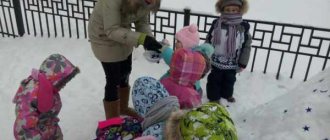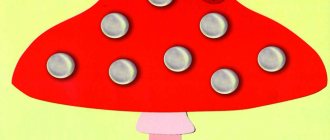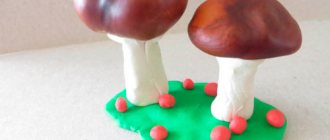GCD move:
Educator: Guys! Do you know who came to visit us today?
The teacher pulls out a big hedgehog
. The children gather in the middle of the room.
The children answer.
Educator: Hedgehog
!
Children looking at a hedgehog
.
Educator: Guys, hedgehog
came to us from the forest. He lives in the forest.
Educator: He is friends with bears, bunnies, and squirrels. And he is afraid of the wolf and the fox. When he sees danger, the hedgehog curls up into a prickly ball and no one can touch him.
Educator: What does he like to eat? The children answer.
Educator: Hedgehog loves mushrooms
, apples, pears and milk
Educator: At home, the hedgehog drinks milk. In winter, the hedgehog sleeps in his hole. That is, in your house.
Educator: Guys, you can’t offend animals. We must love them and treat them with reverence. Look how sad the hedgehog is
.
Let's cheer him up. Children's answers The teacher reads a poem, and the children repeat after him
The hedgehog stomped along the path
And he carried mushrooms on his back (walking in place)
The hedgehog stomped slowly
Quietly the leaves rustle
(we rustle with our palms)
And a bunny gallops towards us,
Long-eared one, jump around.
Something clever in the garden
I got hold of a sideways carrot (jumping in place)
.
Educator: Guys, I invite you to the table. Children sit at tables where there are blanks with the image of a hedgehog without needles
. –
Educator: These are the pictures with the image of a hedgehog lying in front of you
.
Consider the hedgehog. Oh! He's kind of weird! The hedgehog is missing something
. Children's answers.
Educator: That's right, there are no needles! Let's quickly give the hedgehog some needles
!
Like this! The teacher shows how to make hedgehog needles. The teacher invites the children to make plasticine balls for needles: pinch off small pieces of plasticine with the thumb and forefinger of their right hand and roll them into balls. Children roll 2-4 balls each (the rest of the balls are prepared in advance)
.
Then invite the children to place a plasticine ball over the outline of the hedgehog's
, press it with their finger and pull their finger down.
Educator: It turned out to be a needle! Let's give the hedgehog a lot of needles
!
on a hedgehog
. Children and teacher make needles. The teacher helps those who are not doing well. When the work is ready, everyone admires their pictures and the pictures of their comrades.
Educator: Now I suggest you turn into hedgehogs. The teacher shows the kids how to draw a hedgehog
, clasping your fingers together.
The teacher reads a poem, and while reading, the children repeat
the teacher’s movements.
The little hedgehog is frozen
(press your fingers -
the hedgehog removes the needles )
And curled up into a ball.
The sun warmed the hedgehog
(Straighten your fingers -
the hedgehog showed the spines )
The hedgehog turned around
.
The teacher praises the children for their work and says that we will place our hedgehogs at the exhibition so that they will please us and their parents.
Educator: And now it’s time to say goodbye to our hedgehog
, he goes back to his forest.
Children say goodbye to the hedgehog
.
Educator: Guys, we helped make the hedgehog
?
Did you help the hedgehog?
How did we help him?
Publications on the topic:
Notes on sculpting in the second junior group “Who visited us in our garden?” Integration of educational areas: “Cognition”, “Reading fiction”, “Artistic creativity”, “Communication”, “Socialization”.
Abstract of GCD in the second junior group for modeling "Owl" Educational area: Artistic and aesthetic development Integration of educational areas: Artistic, aesthetic, cognitive,.
Abstract of educational activities for modeling in the second junior group “Multi-colored balls for a hedgehog” Integration of educational areas: “Cognitive development”, “Artistic and aesthetic development”. Objectives: 1. Educational: - teach.
Tasks. Develop plot-game concept and imagination. Make chicken figures from individual lumps. Using pulling and pinching techniques.
Program content: Learn to convey the shape of an object (sparrow, divide plasticine into two unequal parts, learn to fasten two parts in order to...
Notes on object modeling in the second junior group “Gift for Dad” Purpose: to make a gift for Dad (tie). Objectives: Educational: Reinforce modeling techniques: develop the ability to separate a piece of plasticine.
Plasticine is a magical material with which you can make incredibly beautiful figures. These can be fairy-tale and cartoon characters, buildings and plants. Animals made from plasticine deserve special attention. For children, modeling will be an incredibly exciting and educational activity, from which it is impossible to escape for a minute.
Plasticine is a magical material with which you can make incredibly beautiful figures.
Sea inhabitants made from plasticine turn out to be extraordinarily beautiful.
Even a child can make such crafts with his own hands. Making a crab requires just a little attention and patience.
Sea inhabitants made from plasticine turn out to be extraordinarily beautiful
Sequencing:
- Make blanks for the body, a pair of claws and eight legs.
- The largest ball from which the body will be made needs to be pressed down a little.
- To make the paws, make sticks from eight blanks.
- Attach four tabs on one side and four more on the other.
- Form claws from the two remaining blanks and attach them to the crab's front legs.
- Place small circles of a lighter material on the body.
- Make eyes.
Pets: how to make a dachshund, cat, cow, pig
Plasticine animals can be very funny and bright. The process of making them is always accompanied by positive emotions. Even pet animals made from this material become an excellent decoration for a child’s room.
Plasticine dachshund
In order to make such a dog, you just need to follow the diagram exactly:
- Roll the black mass into a ball and stretch it out into a long, narrow droplet shape. This part will later become the body of the dog.
- From the wide side, lift the part up.
- Apply the brown mass to the abdomen in an even layer.
- Form a small protrusion - you get a neck.
- To make a head, you need to roll a black and brown ball.
- Extend the black element into the shape of a drop, then stick the brown part to its lower part and extend it a little.
- Using your finger, pull the black material a little onto the nose and highlight the eyes with a stack.
- Now add the pupils and form the ears.
- Attach the head to the neck using a match.
- Make the upper parts of the paws from black material and attach brown elements to the bottom.
- Attach the legs to the body.
- Roll up a thin tube and stick to the abrasions, lifting them up a little.
How to blind a cat
If you follow simple instructions, you will be able to quickly and easily make a funny cat - one of the most beloved pets.
If you follow simple instructions, you can quickly and easily make a funny cat
Progress:
- Using a stack, divide the block of plasticine into three equal parts.
- Roll two parts into balls, and divide the third into six more parts.
- Roll four small pieces into sausages for future legs.
- Roll another small piece a little thinner to make a tail.
- Divide the remaining small part into a couple more identical pieces and make ears from them.
- Form the head and body, then connect these two elements with a match.
- Attach the tail and legs to the body.
Blind the eyes and tongue.
Cow: how to make it with your own hands
The cow sculpting scheme is quite simple and comes down to the following steps:
:
- Roll the brown and orange material into balls and connect them together.
- Attach the eyes, make slits in the form of nostrils, and make a smile with stacks.
- Make horns and attach them to the head.
- Attach ears to the future cow.
- Make an oval out of the brown mass and squeeze it a lot, stretching the neck.
- Make legs and attach hooves made of gray material to them.
- Make an udder from the beige mass.
- Make a tail and then connect all the parts.
Piggy: modeling in stages
This funny pig is easy and quick to make. You just need to strictly follow the instructions:
- Shape the body into a barrel shape.
- Roll four balls and attach them to the body.
- Roll another, but larger ball and also attach it to the body.
- Form a snout and ears.
- Use a match to draw the nostrils and eyes.
Plasticine animals can be very funny and bright
Attach a ponytail wrapped with a crochet hook.





